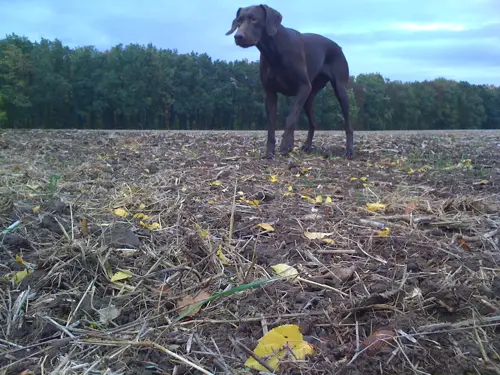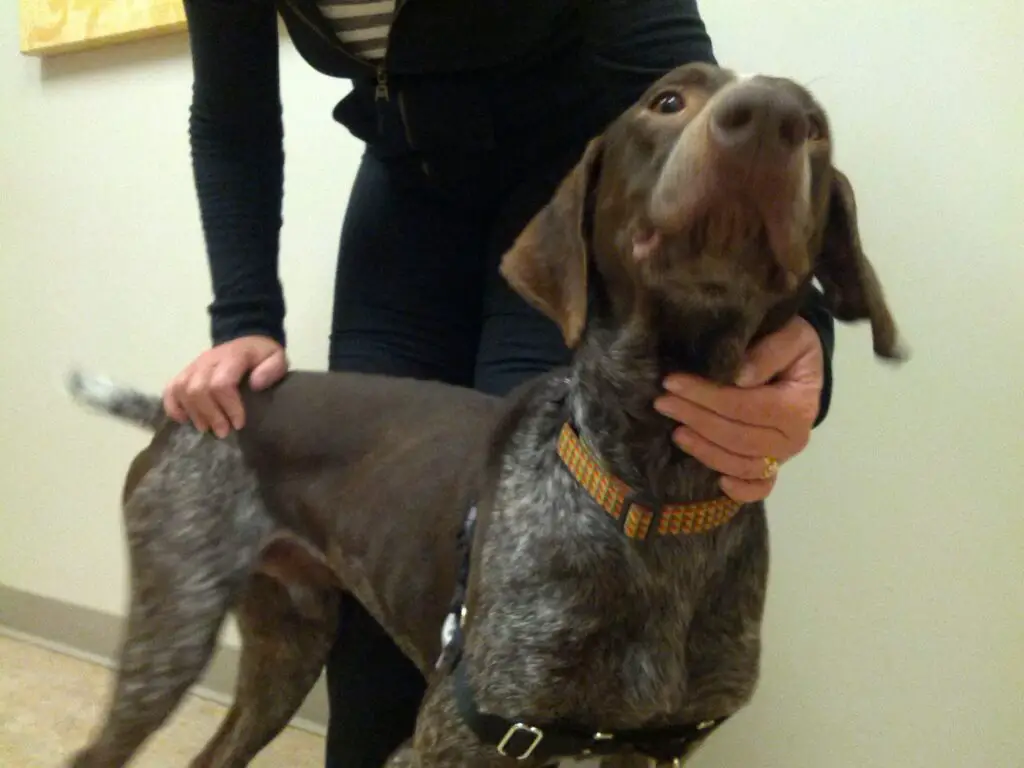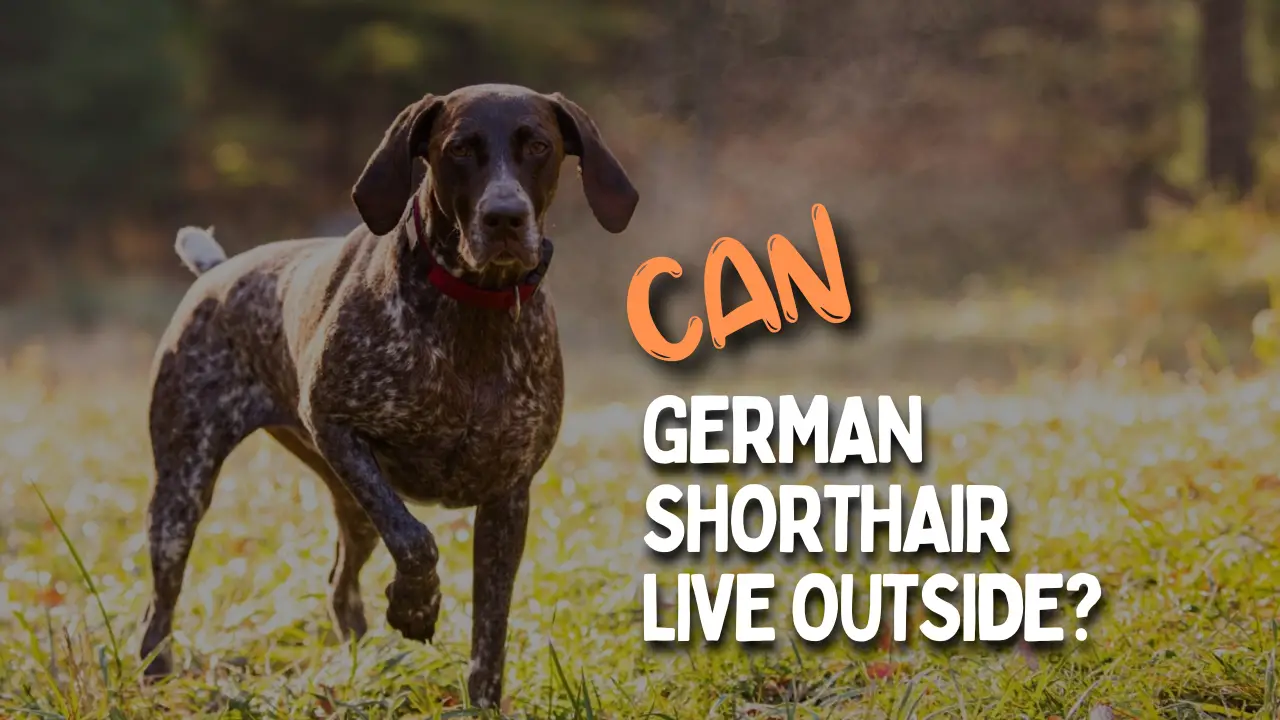A few questions come to mind when thinking of leaving your German Shorthaired Pointer (also called German Bird Dogs) outside:
- Do you have a yard?
- How about small pets in the home?
- What’s the temperature outside like?
- Is it staying outdoors for a couple of hours or permanently situating your dog’s crate outside?
While dogs can generally live outside, your answers to these questions (and more) help in determining if it is ideal for your German Shorthaired Pointer to live outside, risking cold temperatures.
Reasons for Letting Your German Shorthaired Pointer Live Outdoors
Below are a couple of reasons why some dog owners decide to keep their GSPs outside:
- They lack enough space indoors, which makes accommodating their pet infeasible.
- They are trying to avoid their dog knocking over kids or aged relatives with their boisterous attitude.
- Preventing potential damage that might arise if their dog gets destructive because of certain triggers.
Suitability of GSPs Living Outside
In the next few sections, we’ll explore the ideal conditions needed for your German Shorthaired Pointer to live outside:

Climate and Weather Considerations
When considering whether to let your German Shorthaired Pointer live outdoors, the temperature is always an important factor to consider. Nobody would like to stay in a place that is too cold, certainly not a GSP!
They can live outside, but the temperature has to be mild, i.e., between 64 and 86 degrees Fahrenheit, with less than a half inch of rain and dew points below 68 degrees Fahrenheit, which indicates dampness. In simpler words, for them to live outside, the weather must not be too cold or hot.
You should also ensure they’re kept warm in cold weather by making them wear jackets or coats. These dogs have short coats; hence, they’re prone to hypothermia in a cold climate.
Space and Fencing Requirements
GSPs are full of energy. They can keep going and going, which means they’re best suited for families who can keep up with their high energy levels. These dogs also need enough space to run around and play.
If you have a yard, you can have them run around and play without a leash. Just ensure that you have at least a 6-foot tall fence because these dogs can resolve to become escape artists when they crave more stimulation or when they latch onto an interesting smell beyond the fence.
They are also very good at digging and could dig their way under the fence if they get too bored. These are reasons why the German Shorthaired Pointer shouldn’t be left alone for long.
Companion Animals and Human Interaction
GSPs are the perfect companion animal. They love to be with their human friend and could spend hours cuddling with you if they’ve gotten used to you.
Even though we have established they can be outside dogs, they need enough human interaction and regular extensive exercise.
If you ignore them after putting them outside, they could become bored easily, get aggressive or even develop separation anxiety like other pets if you’ve been previously close to them.
Risk of Injury and Disease
The German Shorthaired Pointer is highly likely to develop hypothermia if left or subjected to cold climates for long hours without extra protection. This is because their body isn’t built to withstand cold temperatures, unlike other dog breeds like the Siberian Husky that thrives in cold weather.
For those who don’t know, hypothermia is a dangerous condition that occurs when the core body temperature drops too low. For young and medium-sized dogs, mild hypothermia begins to set in when their body temperature reduces below 99 degrees Fahrenheit and gets severe when the temperature goes down below 82 degrees Fahrenheit.
Taking Adequate Care
German Shorthaired Pointers love having many toys; being playful as they are, they may see your shoes, furniture, or other personal items as their chew toy if not given a dog toy. As a mouthy dog, you need to provide them with steady chew toys.
Also, they are all about food, your GSP always knows when it’s mealtime, and if you’re late for just a minute, they’ll let you know about it. So GSP owners should know mealtime should not be forgotten!
When letting your German Shorthaired Pointer live outside, it is important to ensure that high-quality dog food and water are always available. In addition, they are food motivated, which means you can use food to let them learn commands.
Providing Appropriate Shelter
If you decide you want your German Shorthaired Pointer to live outside, you have to build the perfect kennel for them to live in. You need to ensure that the kennel is spacious, given the size of the GSP.
It should be all warm and cozy, weatherproof, and built in such a way that it can evade cold weather. There should be no holes in the roofing or the side of the kennel. It should be built in such a way that no matter how bad the weather gets, they would have a place to retreat to.
It has to be the perfect kennel, filled with enough blankets, and the bed should be packed with enough straw to be comfortable for your GSP to lay on; at least 4 inches up from ground level would do the trick.

Regular Veterinary Check-Ups
Always take your GSP for regular check-ups to catch any illness or infection on time. The main area of concern in a German Shorthaired Pointer is its ear. Due to its large and floppy ears, there’s no good airflow through the ear canals, which can lead to yeast infections.
It is important to let your vet demonstrate the proper way to take care of your dog’s ear. Good dental health is also essential; you should ensure to always brush their teeth with a firm bristle brush and toothpaste designed just for dogs.
You should also check their eyes and ears from time to time for redness, inflammation, rashes, or any signs of infection.
Adequate Exercise and Mental Stimulation
German Shorthaired Pointers are hunting dogs with boundless energy and are sure to keep you on your toes with their vibrant and active lifestyle. Because of how energetic this breed is, they need regular and extensive exercise. You could let your dog run free for at least an hour daily.
Any responsible breeder would provide organized dog sports with vigorous exercise and crate training to help avoid health issues such as hip and elbow dysplasia and progressive retinal atrophy.
Consistent Training and Socialization
German Shorthaired Pointers get along well with their human family members, no doubt about that. However, due to their hunting heritage, these dogs can be independent thinkers because of which they should only have short but fun and engaging training.
Fortunately, they’re intelligent enough to learn commands. However, they need time to rest after they give their complete focus during training.
In addition, it is just as important to use positive reinforcement techniques when training these dogs, such as food rewards, praise, and plenty of playtimes. As mentioned earlier, GSPs are food motivated, which means the training session can be much easier if their favorite snack is involved.
Conclusion
German Shorthaired Pointers are one of the dog breeds that love to be around their human companion all the time (hence the reason they are classified as Velcro dogs). However, this isn’t always possible.
If your German Shorthaired Pointer is going to be living outside, you should make sure the weather condition is always right for them– not too hot and not too cold.
You also want to ensure you are socializing your dog enough with other dogs and engaging them in as much physical and mental stimulation as needed to prevent them from getting frustrated. Regular vet visits to ensure your pet is always in good health are also a must.
Finally, it is worth noting that GSPs require little care and can live happily in any family. You can end up spending extra if you leave them outside rather than inside. Therefore, whenever possible, let them join you indoors.

